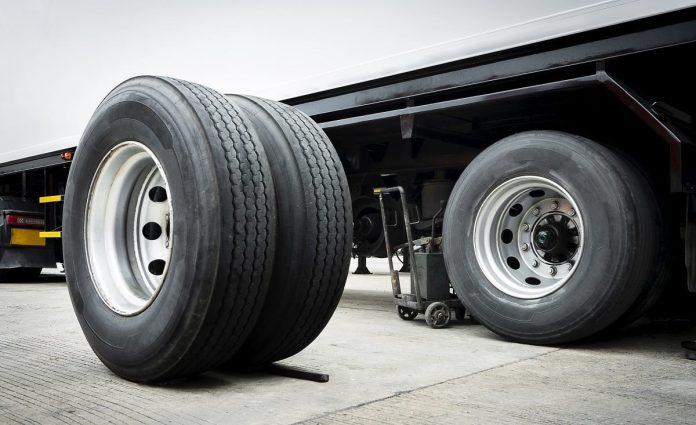By: G. Ray Gompf, CD
The tires you use is as critically important to the safe operation of your truck as the training and experience you have accrued over hundreds of thousands of miles. The condition of the roads, the type of road surface, and the weather have a significant influence on the longevity of your tires equally to the condition and maintenance you put into your truck and the insurance you buy to protect your trucking business.
The various road surfaces have an effect on your tires. Basically, in North America, most road surfaces are either black top asphalt or concrete. Black top asphalt is used in the more northerly climes because it expands and contracts without the upheavals that can happen with cement. Cement is used more southerly because it tends not to absorb heat as much as blacktop. Yes, the road surface temperatures can affect the longevity of your tires.
Rubber compounded tires for summer use provide good road adhesion above seven degrees Celsius, while rubber compounded tires for winter use provide much better road adhesion below seven degrees Celsius. Adhesion to the road is essential to remaining on that part of the road where you want to be. Without sound adhesion, you would not stop when and where needed. Braking and steering may not be achieved as you want. Tires are what attach you to the road.

So basically, you choose your tires based on the surfaces on which you travel based on the seasons, whether north or south.
One of the other issues related to tires is wear patterns. Wear patterns can help diagnose repairable problems either from the driver’s lack of knowledge or solvable mechanical problems. Some of the repairable issues can be as simple as adding or removing air pressure. Alignment issues are quickly reported by wear patterns and close observation at each daily vehicle inspection. Issues like cupping, diagonal gouging, feathering or flat spotting should require a diagnostic trip to your tire shop for professional opinions.
Don’t forget about the fastening devices applying clamping force attaching wheels to vehicle. It’s not just ensuring lug nuts are attaching and continue to be attaching the wheels and tires to the vehicle; it’s about the grip strength of said lug nuts. Usually, this is done by using a torque wrench to reach the specified torque without over torquing, which weakens the connection. This connection is where while making it, cleanliness is absolutely necessary. The addition of a tiny bit of lubricant on the lug is also essential for maximum clamping power.

Buying cheap tires to save money is like stopping the clock to save time. By the same token, the most expensive does not necessarily mean the best for your situation. Buy tires with the full knowledge of the terrain over which you’ll travel, the weights at which you’ll often load them, and the specific compound depending on the temperatures you’ll be facing.
The factors to be considered on purchasing are many and varied but by describing your needs to the tire specialist, you will wind up with the tire that best suits the majority of terrain in which you’ll find yourself. Tires represent a significant investment for fleets and small business trucking operators. It’s usually the third largest expense behind insurance and fuel, and when it comes to tire wear, those frequent daily inspections are the critical first line of defence.
Every one of the multiple driver’s daily inspections should be much more than just thumping the tires. That inspection should include a comprehensive tire examination. During those inspections, rubbing their hands on the tires to check for any feathering, cupping, diagonal wear or overheating and looking for foreign objects and removing such materials attached to tires are crucial. Nails or screws puncturing should NOT be removed until the puncture can be immediately fixed. That puncture should be marked on the tire, so the search doesn’t have to be redone when removal and repair is affected.

Tires quickly expose bad driving habits and poor tire care. Tires easily can indicate driver practices such as brake skids or lack of correct inflation. Tires will also tell the skilled eye when the driver overuses the power steering while stopped.
I recall, not fondly, having both steering tires replaced at a tire shop as planned, then the first trip with those brand-new steering tires, I managed to get about 150 kilometres along the highway when I stopped. As I got out of the truck and was doing the quick walk around, the left steering tire had a king size bulge on the wall of the tire. I called the tire shop, and the boss came out because he didn’t believe I had a bulging problem and if I did, he wanted to see it. When the tire shop boss arrived, he was aghast. It turned out these particular tires were directional tires and had been installed on the wrong direction. Not only did he have one tire to change but the second steer tire would have collapsed within a few more kilometres and thus, was replaced also. Re-torquing is not the only reason to stop and check things out when the wheels have been removed. Image if I had not stopped and the bulge had blown out and I had lost control.

Trucks have three different uses for tires. Each position requirement requires its own engineering and really isn’t built to be working in another position. Steering tires are for steering, drive tires are for moving the truck along, and trailer tires are for trailers. Essentially, tires built for a specific purpose and position should not be used, except in an emergency, for a position or purpose it wasn’t designed to do. Each tire position may have a different tread pattern or even look similar but have their own uses, nonetheless.
Tires are one of those things where the accumulated data is readily available but rarely reaches the end user. During driver training sessions, tires get less importance; yet it’s those same tires on which drivers depend for their life. Over my career, I’ve spent many hours attending sessions learning about the importance of tires, how the tires need to be used, how best to ensure the longevity of those tires, the difference between torque and clamping force attaching wheels by lug studs and lug nuts, whether those lugs and nuts should be dry fit or lubricated and so many things not taught specifically but so necessary to be poured into the knowledge pool and not just for the specialist who does the job but as a driver who has to depend on jobs being done correctly by other. After all, the liability always falls on the driver when catastrophe strikes. It behooves the driver to educate him or herself to the point where they can be a large part of the diagnostic process with a confidence based on experience and knowledge. Driving is not steering and shifting gears but studying the intricacies of the particular truck they drive and knowing it so intimately they can identify issues before they happen by smell, by sight, by feel, by sound and relate those differences to the person charged with doing the repair.


